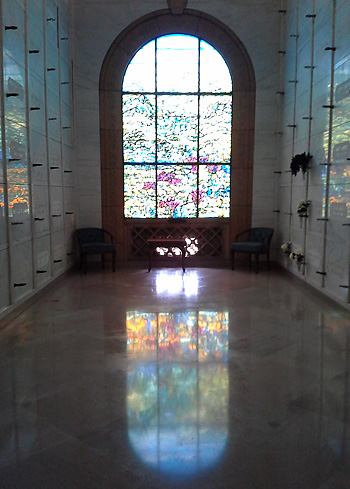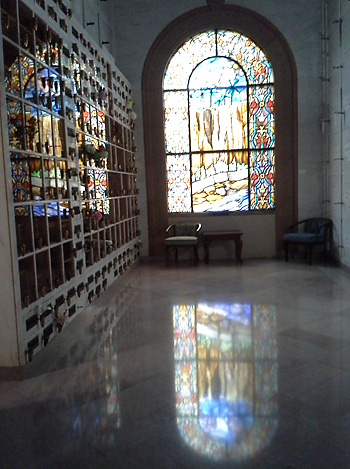Behind The Mask: Hand Building With Clay
I had the opportunity to teach “Hand Building With Clay” to students in grades K – 4 for the City of Santa Monica’s CREST Enrichment program.
After learning the pinch pot, coil and slab techniques, students had the opportunity to use slabs (pancakes of gently flattened out clay) in a different way, by laying the slab of clay over a sort of armature of loosely balled up up newspaper, so that it would harden in a shallow bowl form, and create a mask.
As the forms dried, and the clay hardened, the newspaper was removed, and the clay became ready to paint, embellish and add to.
Some students chose to use the convex surface of their half spheres or hemispheres as a place to create symbolic forms and shapes such as stars and hearts, rather than a face or character.
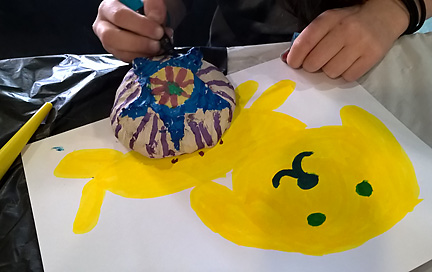 Students played with using the paint pens by working on paper first.
Students played with using the paint pens by working on paper first.
 The paint pens allowed them freedom from choosing and washing brushes, adding water, and controlling “loose” acrylic paints. They could use the paint pens to create intricate patterns like a drawing tool.
The paint pens allowed them freedom from choosing and washing brushes, adding water, and controlling “loose” acrylic paints. They could use the paint pens to create intricate patterns like a drawing tool.
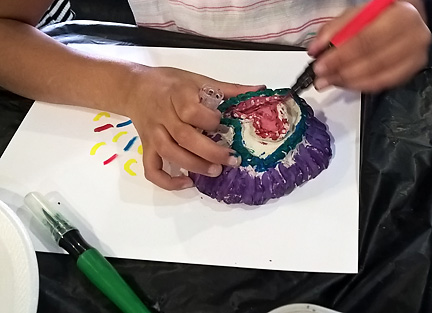 Students learned to pounce or “stipple” with the paint pens, using their tips to apply paint to creases and crevices in the clay.
Students learned to pounce or “stipple” with the paint pens, using their tips to apply paint to creases and crevices in the clay.
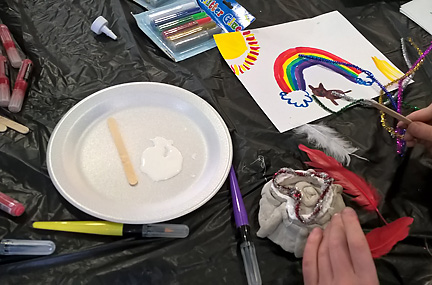 Students could then add feathers, beads, pipe cleaners and other embellishments to their masks, to further develop their characters, designs, forms and images.
Students could then add feathers, beads, pipe cleaners and other embellishments to their masks, to further develop their characters, designs, forms and images.

 Some chose to focus on color through painting, adding a carefully chosen addition to enhance their character.
Some chose to focus on color through painting, adding a carefully chosen addition to enhance their character.
 This young artists has incised, or drawn into the clay to create they eyes, and added clay to build out the nose. The mouth uses both techniques.
This young artists has incised, or drawn into the clay to create they eyes, and added clay to build out the nose. The mouth uses both techniques.
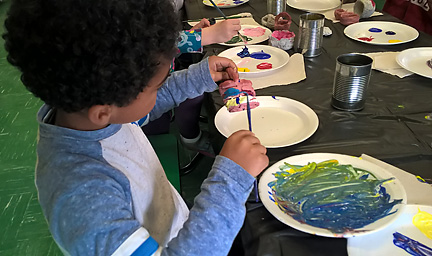 Students used foam plates to mix new colors on, as well as for palettes.
Students used foam plates to mix new colors on, as well as for palettes.
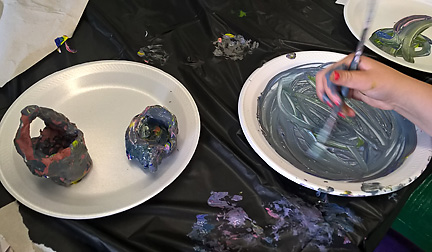 Mixing all the colors together was a popular choice, and helped the students to understand some of the principles of color mixing.
Mixing all the colors together was a popular choice, and helped the students to understand some of the principles of color mixing.
 Detail and focus ruled, even with the younger children.
Detail and focus ruled, even with the younger children.
 This young artist has mixed the secondary colors of green and orange, from his palette of primary colors, red blue and yellow.
This young artist has mixed the secondary colors of green and orange, from his palette of primary colors, red blue and yellow.
 We used both grey and red air dry clay.
We used both grey and red air dry clay.
 Here a young artist mixes green…after painting the outside of the pot blue, and the inside yellow.
Here a young artist mixes green…after painting the outside of the pot blue, and the inside yellow.
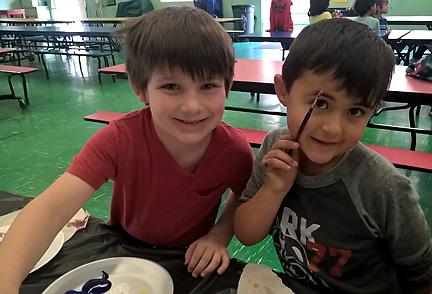 These two kindergarteners had a wonderful time painting and creating together!
These two kindergarteners had a wonderful time painting and creating together!
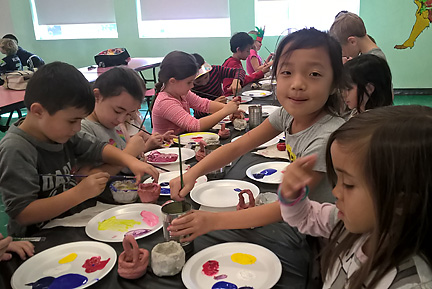 There is something about painting that seems to clear out irritability, and at least temporarily suspend human anxiety.
There is something about painting that seems to clear out irritability, and at least temporarily suspend human anxiety.
It is wonderful to see creative”flow” in action!
 The sweet and talented students ranged from first to fourth grade, and had a blast making books of different sizes, structures and materials.
The sweet and talented students ranged from first to fourth grade, and had a blast making books of different sizes, structures and materials. They first bound together their portfolios, made of hanging file folders, then designed and developed the outside covers of these,
They first bound together their portfolios, made of hanging file folders, then designed and developed the outside covers of these, getting acquainted with each other, their materials, myself, and their own creativity and imagination.
getting acquainted with each other, their materials, myself, and their own creativity and imagination. Then we began our book projects…which included accordion fold books, flag books, fan books,
Then we began our book projects…which included accordion fold books, flag books, fan books,
 To celebrate our achievements, learning and fun, we had a “last class” family event.
To celebrate our achievements, learning and fun, we had a “last class” family event. Family and CREST staff were invited to Make Books Together!
Family and CREST staff were invited to Make Books Together! Did we have fun making “double” single signature books, learning the pamphlet stitch, and embellishing up a storm!
Did we have fun making “double” single signature books, learning the pamphlet stitch, and embellishing up a storm!


























